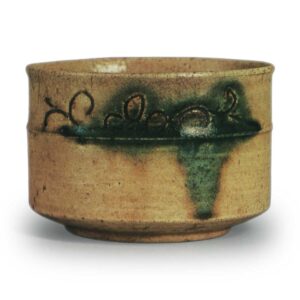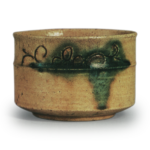
The Mino ceramic production area during the Momoyama period (1573-1600) was, even from today’s perspective, a truly spectacular and colorful development. When we examine the trajectory of this development, we learn that techniques and styles do not improve gradually, but rather rise rapidly and change dramatically when some external stimulus is added. The Mino ceramic industry from the Tensho period to the Bunroku and Keicho periods was exactly such a period. As if in response to the end of the Warring States period from the Eiroku to Tensho periods, a new ceramic style based on traditional techniques and connected with the demand of the apologetic tea world gradually became active from around the Eiroku period. This new style of pottery gradually flourished from the late Tensho period through the Bunroku and Keicho periods. Among the representative ceramics of Mino, Shino Ki-Seto Seto-Kuro-Oribe, Ki-Seto and Seto-Kuro were ceramics with a new sensibility that flourished on top of the traditional techniques of the Seto and Mino pottery industries that had existed since the Kamakura and Muromachi periods.
Shino, with its white glaze and dark, lightly reddish burnt surface, was a unique type of pottery born of the rich Japanese climate, while Kizeto, with its moist glaze, lightly carved patterns, and slightly greenish gauze, has a warm Japanese flavor. While Shino was a new technology that emerged in the late Muromachi period (1333-1573), Kizeto glaze was derived from the Kozeto ash glaze that had existed since the Kamakura period (1185-1333), which was gradually improved to produce the so-called aburai-te Kizeto of the Momoyama period (1573-1600). In Mino, since the Muromachi period (1333-1573), many tea bowls and plates of various sizes had been produced in imitation of wheel-thrown Chinese celadon with a transparent glaze similar to the Kosedo ash glaze, but later, ash glazed wares were produced on top of a decorative oni-plate, and further improvements were made on these glazes. It is estimated that the Kiseto ware with a unique texture of fried skin was completed in kilns such as those under the Oyayama kiln from the end of Tensho to around the time of Bunroku.
The heyday of Kizeto unique to the Momoyama period is thought to have been from the Tensho period (1573-92) to the early Keicho period (1596-1615), and, like Shino and Setoguro, it was produced in anagama kilns. The works that pioneered Momoyama Kizeto are also thought to have begun in the late Muromachi period, from the Tenmon period (1532-55) to the Eiroku period (1558-70), and among those estimated to have been produced during this period are tea bowls that are said to be the favorite of the tea master Hokumukai Do Chen (1504-62). It is believed to have been made in the late Muromachi period, around the time of the tea master Hokumukai Douchen (1504-62). This tea bowl is wheel-thrown and rounded at the waist, and is a mixture of a round bowl and a half-tube bowl. It is a Ki-Seto bowl with an ash glaze over an oniita (a type of clay produced in the Mino region) on the base. Since a Tenmoku bowl with the same glaze tone has also been handed down, it is thought that Ki-Seto ware with this type of glaze tone was widely produced at one time.
Unlike the so-called “fried Ki-Seto” wares that became popular after the end of the Tensho period (1522-91), this type of Ki-Seto tea ware has a well-melted, slightly translucent yellow glaze over the entire surface, and this type of glaze is known to have been widely used. It is assumed that this type of glaze was produced during the Tensho period, followed by the production of aburayote.
Koseto teacups are rare in Koseto, but this is a representative masterpiece that was unusually produced as a teacup. After being wheel-thrown, a spatula was added to the body to create a distinct Momoyama-style semi-tubular shape, and it is thought to have been made in the late Tensho period. It is thought to have been made in the late Tensho period. The brownish brown tamenuri on the prospective surface is similar to that of Setoguro and Shino wares, but the thin glaze shows the traces of spatula shavings on the body. Perhaps because the firing temperature was slightly low, the dark, thin glaze was applied in a moist and thin manner, and some of the glaze was burnt, but it was not fried.
The Koseto Hoshu Kogai (Incense Bowl with Beads) in the collection of the Nezu Museum is also a small but representative example of Koseto teapottery. It has a truly elegant jewel shape, and the yellow glaze applied over the entire surface has a moist texture that is reminiscent of deep-fried tofu, making it a particularly rich piece among the many Momoyama tea ceramics. It is thought that this type of Kizeto became popular from the end of the Tensho period through the Bunroku and Keicho periods, and it has been confirmed that excellent examples of this type of work were fired at an old kiln site excavated by Kato Karakuro at Ohgaya. The main body of Momoyama’s Hwang Seto ware is known to have been made in the same year.
The main part of Momoyama Kizeto was not pure tea ceremony utensils as described above, but high-end tableware of the time, such as mukozuke (tea bowls) and pots. Of course, since the late Muromachi period (1333-1573), Mino had been mass producing large and small plates and other tableware modeled after celadon and white porcelain imported from China in the Yuan and Ming dynasties. One of the representative examples is “Kizeto Tea Bowl,” which is now used as a tea bowl. It has a low base and a semi-tubular shape, but the body is covered with a so-called “body cord,” and an arabesque pattern is carved in lines on it. Over the design, a copper-red green glaze, called “gallbladder” in Koseto, is applied, and the glaze has a soft, moist texture that is suitable for an aburai-te (oil-glazed) ware. The yellow glaze of the Seto Mino region, which began with Kosedo, became refined and tasteful in the Momoyama period (1568-1600).
Among Kosedo tableware, the “Kosedo iris-patterned glazed flower bowl” is famous as a large work. The term “iris-formed Koseto” is said to be derived from this piece. It is a gongbachi style bowl with a glazed floral pattern on the rim of the sword-shaped mouth structure, and this type of bowl was modeled after the Ming Dynasty lacquerware and kimono trays of China. However, qualitatively, the work shown here is completely Japanese in style, and does not have a Chinese flavor. The design of the iris on the front is painted with powerful lines, and the leaves are decorated with dark blue vitriol, creating an outstanding decorative effect.
The “Koseto tableware with chrysanthemum string lid” is also an outstanding example of Koseto tableware. Koseto tableware is generally formed very thin, and although this “Mukozuke with chrysanthemum cord lid” is a thin piece, its rounded shape is unique to Momoyama. Moreover, the chrysanthemum branch design and the design of the cloves on the underside of the lid, which are carved in lines, have a deep tea-like quality, suggesting that the craftsmen of Momoyama were looking for a different kind of beauty in Kizeto from that of Shino and Oribe.
This kind of moist texture is called abura-age hand. Kizeto, which is called Shobu-te, was only produced in large half-ground kilns, but the period was short-lived. In the Keicho era (1596-1598), when most of the kilns in Mino were converted to continuous climbing kilns, good quality pieces were no longer fired, and the climbing kilns were more suitable for this purpose. Later, it was changed to yellow glazed ware called “Omamaiyaki” or “E-Seto”.
Hakuan Tea Bowl
One of the most unique Ki-Seto type works is the so-called Hakuan Tea Bowl. Hakuan tea bowls are said to have gotten their name from the fact that they were once owned by Sotani Hakuan, a medical official of the Shogunate. Although it is not yet known where in the Seto area this bowl was made, it is thought to have been made from the Keicho period to the Genna and Kan’ei periods, judging from the clay taste and glaze tone. The characteristic of Hakuan handles is that they are different from Seto-style wares in general, and are similar to Karatsu-style wares made on the potter’s wheel, and their appearance is also similar to Okukoryo and Koryo tea bowls. Therefore, in recent years, some people believe that these bowls are not from Seto or Mino, but from Karatsu or the Korean peninsula. In the Keicho era, a Karatsu-style climbing kiln was built in the former residence of Kusjiri, and in Karatsu, a large number of pottery with patterns that seem to have been copied from Shino were produced. Therefore, it can be inferred that the exchange between Mino and Karatsu was deeper than what is reported in geographical records, and it is not surprising that at one time, special Karatsu-style ware was produced in Mino. I have also speculated that the work may have been produced in the Kyo Seto style, but this is a hypothesis based on the fact that there is a Kyo Seto potter who is known as Hakuan. There is a note written by Enshu Kobori on the cover of the box of Hakuan Tea Bowl, which indicates that it was fired in Seto or Mino kilns, and it must be highly credible because Enshu wrote “Seto Hakuan” on it not too long after the period when Hakuan Tea Bowl was produced.
The feature of Hakuan Tea Bowl is that it is wheel-thrown in a seemingly straightforward bowl shape, but the overall style is quite intentional. The consciously made crack on the body and the sea squirt glaze applied from the crack is not natural, but a common practice among all Hakuan bowls. The base of each piece is carved into a single thin base, and the area around the base is covered with a thick yellow glaze, which melts well and is almost like the Ki-Seto glaze used on sake cups. There are more than a dozen of these bowls in existence today, but I have seen several other plain bowls of similar style without a single character crack or sea squirt glaze. However, most of them have a common promise, so they must have been specially ordered at a certain time.








